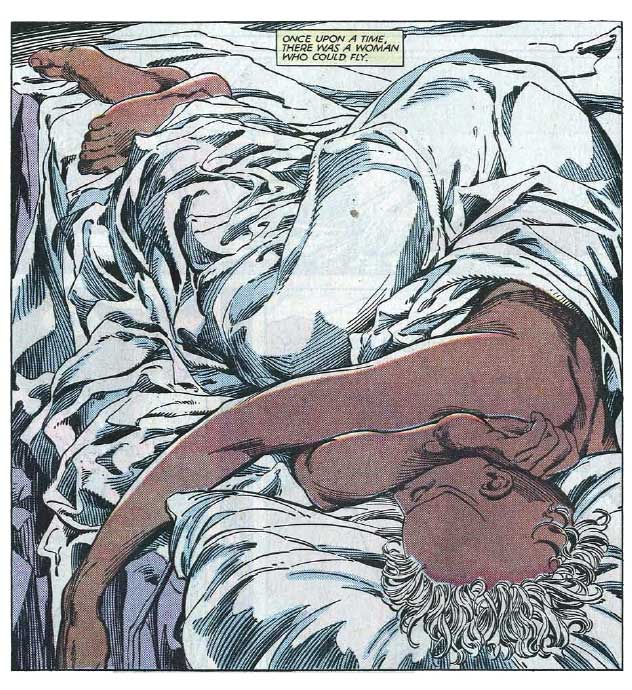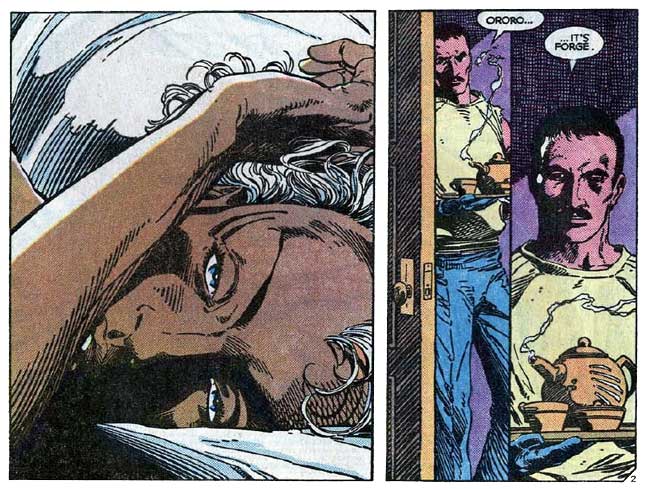One of the most celebrated runs in 1980s comics hit a major milestone in ’84, leaving a mutant without her powers for the first time. How do you deal with the loss of something that defines your very existence? Your Major Spoilers (Retro) Review of Uncanny X-Men #186 awaits!
 UNCANNY X-MEN #186
UNCANNY X-MEN #186
Writer: Chris Claremont
Penciler: Barry Windsor-Smith
Inker: Terry Austin
Colorist: Glynis Wein/Christie Scheele
Letterer: Tom Orzechowski
Editor: Ann Nocenti
Publisher: Marvel Comics
Cover Price: $1.00
Current Near-Mint Pricing: $5.00
Previously in Uncanny X-Men: Born in Kenya, Ororo Munro grew up on the streets of Cairo, becoming skilled as a pickpocket and thief, using her skills to survive. As a teen, she developed the ability to control local meteorological phenomena, becoming the center of a cult, worshipped as a wind-goddess. It was there that Charles Xavier found her and recruited her to his second (or possibly fourth now, thanks to retconning) team of X-Men as Storm. She served with valor, eventually taking leadership of the team, but during a conflict with the U.S. government, she threw herself in the path of a blast meant for the dangerous rogue mutant called… Rogue…
What? I don’t writes ’em, I just explains ’em. Aaaanyway, the blast was actually a neutralizer designed by a genius scientist called Forge to destroy the alien Dire Wraiths, and the blast left Ororo without her mutant powers…

As our story opens, Ororo is clearly in the throes of a deep depression, uncommunicative and unwilling/unable to get out of bed. Of course, this isn’t her own bed, safe in the attic at the Xavier School, but instead the home of the very man whose Neutralizer caused the whole situation…

This issue is one of the first experiences that teenage me had with the work of Barry Windsor-Smith, and I have to tell you: Teenage me didn’t like it.
That said, teenage me was a giant doucheketeer and cannot be trusted in many matters of quality, and was also heavily enamored of the work of John Romita, Jr., the regular X-Men artist at the time. My artist biases aside, this comic book is heavily memorable, not only for the ingenious design work in Forge’s pad, but also his holographic generators, which get a real workout…

While Forge wonders if he’s qualified to provide post-traumatic care to a woman who is clearly in emotional turmoil (Hint: He is not.), he also recaps the plot to this point, even visually recapping the sequence of events that led to Storm’s depowering…

There are a lot of complaints about Shooter-era Marvel, but the insistence on clearly explaining what happened previously in every single issue isn’t one of them, and Claremont and Windsor-Smith are ingenious in weaving the expositionary recap into the emotional story being told. As Forge’s reenactment reaches the point where he saves her, Ororo arrives, bluntly telling him, “You should have let me drown.”
Meanwhile, in Salem Center, the other X-Men search in vain for their lost leader, with even the vaunted psychic might of Professor X unable to locate Storm’s whereabouts…

The answer is, of course, unthinkable: Cerebro can’t find her because she is, in effect, no longer a mutant. Back in Forge’s lair, Storm and Forge wonder whether or not Rogue might have survived the battle, and she slowly warms to the Cheyenne’s charms. She also has to come to terms with the mutant equivalent of a phantom limb…

Unfortunately for Forge, his limitations as a therapist lead to conflict (which, to be honest, is pretty much par for Forge’s course in the comics; he’s a fave-rave X-Man, but not a particularly sensitive human being), and Ororo (you should excuse the expression) storms off. Later, she joins him in the pool, and finds out that Forge might understand a little bit more about her loss than she expected when she sees his prosthetic leg…

I’ll be honest: I’m still not sure how the metaphor of “lost mutant powers” for “lost limb” is out-of-universe. There is a lot of room for that to be super-offensive, but the combination of Claremont’s character work and Windsor-Smith’s art successfully pushes most of that out of my head during the reading. Still, realizing that Forge might understand a little of what she’s feeling helps Ororo to open up to the possibility of healing, even deciding to get up and dressed and ready to face the world again…

Her lovely gown throws a wrench of mutual attraction into the healing plans, and Storm changes into something more casual outfit for dinner. The two mutants have a very cute, sweet bonding moment over dinner and champagne, before Forge once again makes a misstep…

His holographic storm throws woman Storm into a full-on panic attack, and things only get worse when Forge has to take an urgent call from Henry Gyrich, the very man who fired the neutralizer that removed her powers…

In between the panels of this story, Rogue found herself attacked by Dire Wraiths, even absorbing some of their alien nature, forcing her to join forces with Val Cooper, government liaison. In order to survive, Rogue absorbed Val’s memories, leaving her in a coma. The knowledge that she has been taking refuge and/or flirting shamelessly with the very man responsible for her situation throws Storm into a panic, and she tries to run.
Instead, she triggers Forge’s holo-generators, and somehow triggers his recreation of the Vietnam-era attack that cost him his leg…

That, by the way, is some really dangerous stuff to have easily accessible, as the generators also have some sort of physical component, and each blast of napalm feels nearly real. The chaos continues until the inventor arrives, calmly telling Storm that his device was used without authorization, and that she is safe now.
It’s an argument that would have gone better BEFORE she was nearly blown to bits.

He tries once again to calm her, but his tender hand is met with a closed fist, and rightfully so. Storm’s punch knocks him for a loop, and she calls him on his foolishness, dubbing him the ‘Master Of Lies’ and rejecting his both his help and his romantic overtures…

Storm’s final sweeping declaration does prove to be true, though not for a couple of years in comics, and her relationship with Forge never quite materialized the way this issue foreshadowed, but it’s a turning point for the X-Man leader. This issue is also a major component in why there are Forge-fans, introducing the new character with a flourish, even though he didn’t officially join the X-Men for a few years. In short, Uncanny X-Men #186 is an artifact of a wonderful, chaotic time in X-Men history, where every issue changed the status quo and threw additional conflict into the mix, but there weren’t 86 heroes to keep track of, earning a well-deserved 4 out of 5 stars overall. It’s Claremont doing some of his most-inspired character work, with art like nothing we’d seen in the book before, and it’s definitely worth the five bucks to track down a back-issue. (Just don’t get scammed by people who want to sell it for $20 or more, those guys are jerks…)
[taq_review]



2 Comments
This is probably the longest period of comic book I think is consistently ranging from pretty good to outstanding. From 1977 to 1992. I don’t think any other book has as long good run as the X-Men, at least as far as I’m aware of.
I have a run of Uncanny X-Men from 150 to 300. This issue is in my top 10.
Thanks for the great review.